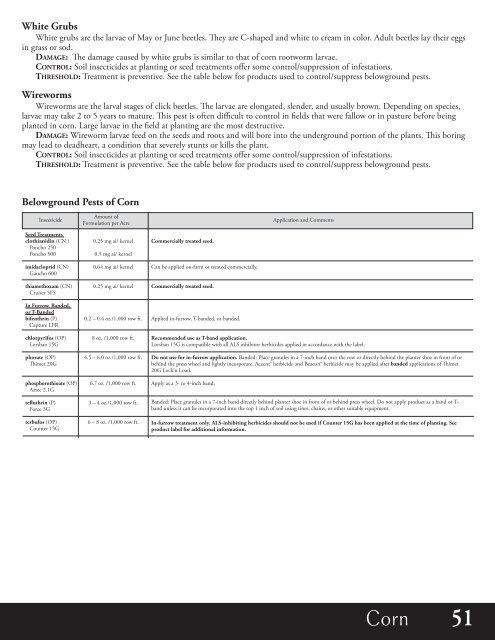Agronomic Crops
mJyPrJ
mJyPrJ
Create successful ePaper yourself
Turn your PDF publications into a flip-book with our unique Google optimized e-Paper software.
White Grubs<br />
White grubs are the larvae of May or June beetles. ey are C-shaped and white to cream in color. Adult beetles lay their eggs<br />
in grass or sod.<br />
DAMAGe: e damage caused by white grubs is similar to that of corn rootworm larvae.<br />
ContRoL: Soil insecticides at planting or seed treatments offer some control/suppression of infestations.<br />
tHResHoLD: Treatment is preventive. See the table below for products used to control/suppress belowground pests.<br />
Wireworms<br />
Wireworms are the larval stages of click beetles. e larvae are elongated, slender, and usually brown. Depending on species,<br />
larvae may take 2 to 5 years to mature. is pest is often difficult to control in fields that were fallow or in pasture before being<br />
planted in corn. Large larvae in the field at planting are the most destructive.<br />
DAMAGe: Wireworm larvae feed on the seeds and roots and will bore into the underground portion of the plants. is boring<br />
may lead to deadheart, a condition that severely stunts or kills the plant.<br />
ContRoL: Soil insecticides at planting or seed treatments offer some control/suppression of infestations.<br />
tHResHoLD: Treatment is preventive. See the table below for products used to control/suppress belowground pests.<br />
Belowground Pests of Corn<br />
Insecticide<br />
Amount of<br />
Formulation per Acre<br />
Application and Comments<br />
seed treatments<br />
clothianidin (CN )<br />
Poncho 250<br />
Poncho 500<br />
imidacloprid (CN)<br />
Gaucho 600<br />
thiamethoxam (CN)<br />
Cruiser 5FS<br />
In Furrow, Banded,<br />
or t-Banded<br />
bifenthrin (P)<br />
Capture LFR<br />
chlorpyrifos (OP)<br />
Lorsban 15G<br />
phorate (OP)<br />
imet 20G<br />
phosphorothioate (OP)<br />
Aztec 2.1G<br />
tefluthrin (P)<br />
Force 3G<br />
terbufos (OP)<br />
Counter 15G<br />
0.25 mg ai/ kernel<br />
0.5 mg ai/ kernel<br />
0.64 mg ai/ kernel<br />
0.25 mg ai/ kernel<br />
0.2 – 0.4 oz./1,000 row ft.<br />
8 oz. /1,000 row ft.<br />
4.5 – 6.0 oz./1,000 row ft.<br />
6.7 oz. /1,000 row ft.<br />
3 – 4 oz./1,000 row ft.<br />
6 – 8 oz. /1,000 row ft.<br />
Commercially treated seed.<br />
Can be applied on-farm or treated commercially.<br />
Commercially treated seed.<br />
Applied in-furrow, T-banded, or banded.<br />
Recommended use as t-band application.<br />
Lorsban 15G is compatible with all ALS inhibitor herbicides applied in accordance with the label.<br />
Do not use for in-furrow application. Banded: Place granules in a 7-inch band over the row or directly behind the planter shoe in front of or<br />
behind the press wheel and lightly incorporate. Accent® herbicide and Beacon® herbicide may be applied after banded applications of imet<br />
20G Lock’n Load.<br />
Apply as a 3- to 4-inch band.<br />
Banded: Place granules in a 7-inch band directly behind planter shoe in front of or behind press wheel. Do not apply product as a band or T-<br />
band unless it can be incorporated into the top 1 inch of soil using tines, chains, or other suitable equipment.<br />
In-furrow treatment only. ALs-inhibiting herbicides should not be used if Counter 15G has been applied at the time of planting. see<br />
product label for additional information.<br />
Crop Name Corn 51


